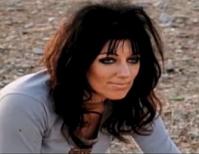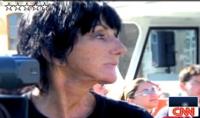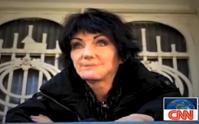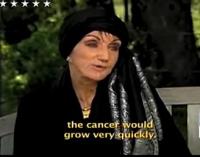The Margaret Moth Story: FEARLESS (or: A Heroine Just Walked Into My Life)
 Susan's update, January 30, 2013: honoring Margaret Moth on her birth date.
Susan's update, January 30, 2013: honoring Margaret Moth on her birth date.
Susan's update, March 21, 2010: Margaret Moth, a woman whose courage almost defied belief, died today at the age of 59. While she would not have cried, I sit here with tears streaming down my face for the loss of a woman I never knew, but who deeply impacted me and countless others around the world.
Thank you Margaret Moth for a life well lived. You will be remembered. Her obituary is here on CNN.
This is what I wrote when I first discovered her story in 2009:
Journalist and camerawoman Margaret Moth is one of a kind.
No doubt. No argument. And definitely no tears.
Born Margaret Wilson, Moth changed her last name after asking herself what stopped her from having her own moniker rather than inheriting her father’s, or adopting a husband’s.
Her choice was inspired, she says, by a friend’s Tiger Moth plane, from which she frequently sky dived as a young woman.
Aside from the fact that she chose her own name, Moth was unique in other ways. She was, for example, the first female camerawoman in New Zealand (and Australia).
But the name change, and the first-in-her-field distinction are minor details in the landscape of Moth’s amazing life.
What really sets her apart are her devotion to her work, her complete and utter fearlessness, and the strength of her character -- even, maybe even ESPECIALLY, in the face of death. She doesn't consider herself a heroine. But many others do.
Legendary CNN correspondent Christiane Amanpour says in a September 2009 CNN documentary that she felt quite intimidated by the “larger than life” Moth before she met her in Sarajevo in the early 1990s.
Moth, says Amanpour, was extraordinary in how she looked, dressed and behaved in those early days. Describing how Moth, who wore black almost exclusively, behaved in the field, Amanpour says:
“You know what? She sleeps with her dark combats boots on…”
In the compelling three-part CNN documentary, one colleague after another describes Moth’s incredibly brave (some might say foolish), behaviour in the midst of conflict and war, where she did whatever it took to film what was happening ‘up close and personal,’ often with complete disregard for her own safety.
 On July 23, 1993, Moth, who was with colleagues in the back seat of a vehicle, all of them on assignment, was hit in the face by sniper fire.
On July 23, 1993, Moth, who was with colleagues in the back seat of a vehicle, all of them on assignment, was hit in the face by sniper fire.
“I don’t remember the actual shot,” she says. “But I remember it must have knocked me over…. It felt like my face was falling off… I was trying to hold it on. I knew I had to keep calm, and that I had to stay conscious. If I go unconscious (I said to myself), I’ll stop breathing. I knew that.”
As it turned out, the bullet had ripped apart Moth’s lower jaw, a good portion of which was gone, along with the base of her tongue.
CNN Correspondent Amanpour Comes Close To Tears
Amanpour paints a picture of what Moth looked like in hospital:
“She was completely enveloped in bandages, her face was unrecognizable, she was SO badly wounded. And the only thing I recognised was her hands. She had very distinctive, strong hands….”
“I remember distinctly,” says Amanpour, “that it was while we were visiting her (in the hospital), that the assignment editor from the international desk called, and he said to me: ‘So Christiane, are you ready to go back to Sarejevo,?’ and I thought, apart from how insensitive can you be? I’m in this room with my colleague who’s been wounded beyond recognition, and then I said, yes….”
At this point, the war-steeled Amanpour stops to gather herself. It’s evident that she is overcome with emotion, and is fighting back tears.
“I said I’d go back, and I know to this day,” she says her voice cracking, “that if I had not said yes then, I probably never would have gone back and I probably never would have done this career, but I said yes because I couldn’t say no…”
Read into that statement what you will.
 After more than a dozen surgeries to rebuild her jaw, Moth returned to the Sarajevo war zone in 1994, wearing – she tells her colleagues jokingly in the film – a bulletproof vest.
After more than a dozen surgeries to rebuild her jaw, Moth returned to the Sarajevo war zone in 1994, wearing – she tells her colleagues jokingly in the film – a bulletproof vest.
Her boss, who, afraid for her safety, as well as the repercussions if she was wounded again, didn’t want to send her back out to the field, but Moth, he says, “was determined to go.”
Moth's colleague Mark Phillips supports the decision and says: “She was more than OK. She was happy to work. She just wanted to come back and work.”
Another colleague describes what he calls a “representative” example of Moth’s character - a story in which she walks in the midst of a crowd in Palestinian leader Yasser Arafat’s compound, while her colleagues fall back behind barriers for fear of being shot.
Photographer Mark Phillips chuckles when he talks of Moth dragging him up and down sniper alley in Sarejevo, and quips:
“The reason they call it sniper alley is ‘cause they used to shoot at you. And Margaret would like run between the buildings, and I was attached on a cable to her doing sound, so when she ran, you had to run, so I had to kinda’ like just be ready to go when she was ready to go, and sometimes I wasn’t and you’d feel the cable tug and you were running out into the view of the snipers whether you liked it or not….”
No Death Wish
Moth, who comes across in the documentary as a beautiful, headstrong, courageous, adventurous woman with a spirit that, despite its singularity, reaches and touches those around her in the most astonishing ways, says:
“People say: ‘Oh people like you have a death wish.’ And that used to make me so angry. I thought: don’t you dare insinuate I have a death wish. I don’t know anyone who has enjoyed life more or who values my life more.”
 Surgeon Dr. Paul Petty, who was involved in her care when she was shot in 1992, describes Moth as “the antithesis of ‘herd animal.’”
Surgeon Dr. Paul Petty, who was involved in her care when she was shot in 1992, describes Moth as “the antithesis of ‘herd animal.’”
“She is a solo artist,” Petty says. “And what distinguishes a non-herd animal as a human being is their demand of themselves that they go forward into the darkness with their eyes open looking straight into it as opposed to their eyes covered backing into it, which is what most of us humans choose to do as a group.”
One colleague says “It was always great to learn that Margaret was on your assignment, because you knew you were going to have a good time….”
Correspondent Hala Gorani, who is no shrinking violet herself, and who found herself “annoyed” at times by Moth’s refusal to do things that conflicted with her (Moth's) values, greatly respects Moth’s individuality.
“She does not give a TOSS what anybody thinks about her,” says Gorani. “She has absolutely her own unique set of values, of what she thinks is important in life. She doesn’t care about the establishment, the whole ‘what is expected of women.’ I mean, she’s a true pioneer.”
(Click here to watch the three-part video tribute to Moth’s life)
Accolades Haven't Changed Her
During a 40-year-career, Moth has won numerous awards.
Her long-time friend and colleague Barrington West pays her, in the CNN piece, what in my view is the highest of all compliments:
“The remarkable thing is that Margaret as a young woman is probably the same Margaret that you see today,” he says. “Partly because she was so certain of what life had to offer, and was equipped with the intellect, and wit and passion to actually pursue it, and achieve what she has in her life.
 Two and a half years ago Margaret Moth was diagnosed with terminal cancer, a fast growing cancer of which she is not afraid. She underwent treatment, but it hasn't changed the outcome, about which she appears to be comfortable.
Two and a half years ago Margaret Moth was diagnosed with terminal cancer, a fast growing cancer of which she is not afraid. She underwent treatment, but it hasn't changed the outcome, about which she appears to be comfortable.
In September 2009, she went into hospice. There’s no doubt she continues to be fearless now, just as she has been her entire life: forging her own path in the crossfire, bravely, with humour, clad in black and with the utmost panache.
I’m absolutely certain she’s not crying as I write this. But I am.
Thank you Margaret Moth for a courageous, adventurous, brave life well-lived.
from which this blog entry was written.
Thank you, Margaret Moth for a life fully lived, with courage, valour and grace.
Thank you CNN for documenting Moth's life.
Thanks to Bébhinn Kelly (Hellwafashion), a pioneer in her own right,
for leading AWR to Margaret Moth's story.
Related Articles
- Fearless Photojournalist Margaret Moth Dies March 21, 2010
- 50 Million Solutions: The Girl Effect.
- 50 #TEDxWomen Quotable #Quotes
- 50 Pearls of Everyday Feminine Wisdom
- 50 Sexy Shoes to Strut Your Stuff In
- 50 Facts: A Rape Reality Index
- Hot List of 50+ Cool Organisations to Empower Girls
- Margaret Moth (Journalist/Camerawoman)
- AAA Alphabetical TED Women Talks List
- 50 Pearls of Amazing Feminine Wisdom